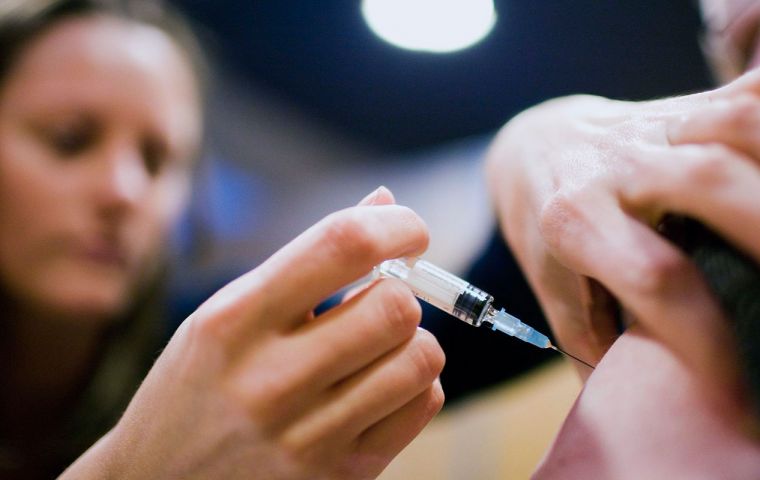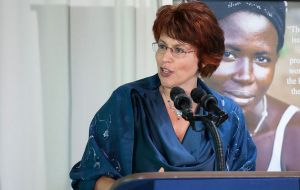MercoPress. South Atlantic News Agency
WHO calls for renewed efforts in global vaccination targets for 2015
 In 2013 nearly 22 million infants missed out on the required three doses of diphtheria-tetanus-pertussis-containing vaccines (DTP3)
In 2013 nearly 22 million infants missed out on the required three doses of diphtheria-tetanus-pertussis-containing vaccines (DTP3)  “World Immunization Week creates a focused global platform to reinvigorate our collective efforts to ensure vaccination for every child” said Dr. Flavia Bustreo
“World Immunization Week creates a focused global platform to reinvigorate our collective efforts to ensure vaccination for every child” said Dr. Flavia Bustreo Progress towards global vaccination targets for 2015 is far off track with 1 in 5 children still missing out on routine life-saving immunizations that could avert 1.5 million deaths each year from preventable diseases. In the lead-up to World Immunization Week 2015 (24 -30 April), the World Health Organization (WHO) is calling for renewed efforts to get progress back on course.
In 2013 nearly 22 million infants missed out on the required three doses of diphtheria-tetanus-pertussis-containing vaccines (DTP3), many of them living in the world’s poorest countries. WHO is calling for an end to the unnecessary disability and death caused by failure to vaccinate.
“World Immunization Week creates a focused global platform to reinvigorate our collective efforts to ensure vaccination for every child, whoever they are and wherever they live,” said Dr Flavia Bustreo, WHO Assistant Director-General, Family, Women's and Children's Health. “It is critical that the global community now makes a collective and cohesive effort to put progress towards our six targets back on track.”
In 2012, all 194 WHO Member States at the World Health Assembly endorsed the Global Vaccine Action Plan (GVAP), a commitment to ensure that no one misses out on vital immunization. However, a recent independent assessment report on GVAP progress rings an alarm bell, warning that vaccines are not being delivered equitably or reliably and that only one of the six key vaccination targets for 2015 is currently on track – the introduction of under-utilized vaccines.
Many countries worldwide have experienced large measles outbreaks in the past year, threatening efforts to achieve the GVAP target of eliminating measles in 3 WHO Regions by end-2015.
A global collaborative drive for immunization, begun in the mid-1970s, with the establishment of the Expanded Program on Immunization in all countries, achieved dramatic results, raising vaccination levels from as low as 5% to more than 80% in many countries by 2013. WHO estimates that today immunizations prevent between 2 and 3 million deaths annually and protect many more people from illness and disability.
Although progress has stalled in recent years, this early success demonstrates the potential of vaccines, which are increasingly being extended from children to
adolescents and adults, providing protection against diseases such as influenza, meningitis and cervical and liver cancers.
The GVAP recommends three key steps for closing the immunization gap:
• Integrating immunization with other health services, such as post-natal care for mothers and babies;
• strengthening health systems so that vaccines continue to be given even in times of crisis; and
• ensuring that everyone can access vaccines and afford to pay for them.
Dr Jean-Marie Okwo-Belé, Director of Immunization, Vaccines and Biologicals at WHO, says the Organization will work to increase its support to all countries that are lagging behind in meeting immunization targets. In May this year, WHO will bring together high-level representatives of 34 countries with routine vaccination (three doses of DTP3) coverage of less than 80% to discuss the challenges faced by countries and to explore solutions to overcome them.
Although many countries are already vaccinating four out of five children with DTP3, a full one-third of countries are still struggling to reach the ‘fifth child’, meaning millions of children remain at risk of illness, disability or death because they are not getting the immunizations they need.
“There is no one centralized approach that can ensure vaccines are delivered and administered to each child. Vaccination plans on the ground need to be adapted not just to countries, but to districts and communities,” said Dr Okwo-Belé. “What is required is a truly concerted effort and much stronger accountability so that each one of the key players involved fulfills its mandate and helps close the immunization gap.”




Top Comments
Disclaimer & comment rules-

-

-

Read all commentsThankfully our government has just ended the farcical exemption due to religious convictions after it was found that no single religion in Australia objects to vaccinations.
Apr 28th, 2015 - 01:38 am 0However if people still choose not to vaccinate then that is their choice. The government has chosen to remove tax benefits and breaks from those people.
A$15,ooo lost per year because you believe lies written on the internet over medical proof..... seems fair.
It's all about choice after all.
Hear, hear !!
Apr 28th, 2015 - 01:43 pm 0Yeah you watch our vaccination rates jump back to their previous levels. A$15,000 per year over 18 years is worth A$300,000 (US$240,000) - now admittedly not everyone will be eligible for that, but let's see if people's beliefs and Google searches are potentially worth A$300,000.
Apr 28th, 2015 - 10:48 pm 0Sometimes the problem with living in a safe and rich developed nation is that people forget what it is like not to. They forget what it was once like only a generation or two earlier.
When I was a child, my mother had a friend who had pockmarks on her face. I'd never seen this before and she told me it was from a disease that was around when she was a little girl but didn't exist any longer. I didn't understand the implications fully at that age.
But now that I think about it. Few people I know who are my age or younger will even know what smallpox scars actually look like. I was never immunised against smallpox but you still see that vaccination scar on many arms of most people who emigrated here.
In about 10 years we will look back and see this current kerfuffle over vaccination as silly. There will be fewer incidences of disease.
Commenting for this story is now closed.
If you have a Facebook account, become a fan and comment on our Facebook Page!